Continued Drug Use on Probation parole is a Common Reason for
Probation and Parole Systems Marked by High Stakes, Missed Opportunities
1 in 55 adults is under community supervision

Overview
Incarceration has long dominated the national conversation on criminal justice, because the U.S. prison population skyrocketed between the 1980s and late 2000s. Starting in 2007, policymakers seeking to protect public safety, improve accountability, and save taxpayer dollars initiated a wave of bipartisan reforms that has reduced the number of people behind bars in many states. Yet this movement has largely overlooked the largest part of the correctional system: community supervision.
Nationwide, 4.5 million people are on probation or parole—twice the incarcerated population, including those in state and federal prisons and local jails. The growth and size of the supervised population has undermined the ability of local and state community corrections agencies to carry out their basic responsibilities to provide the best public safety return on investment as well as a measure of accountability. Although research has identified effective supervision and treatment strategies, the system is too overloaded to implement them, so it sends large numbers of probationers and parolees back to prison for new crimes or for failure to follow the rules.
As part of a collaborative effort to improve the nation's community corrections system, The Pew Charitable Trusts and the Laura and John Arnold Foundation analyzed the leading research and identified the most pressing problems and some promising solutions. The available data leave many questions unanswered, but this review reveals key insights and challenges many assumptions about supervision. Among the findings:
Community corrections is marked by considerable growth and scale, disproportionate representation of men and people of color, and a majority of people who committed nonviolent offenses.
- 1 in 55 U.S. adults (nearly 2 percent) was on probation or parole in 2016 (the most recent year for which data are available), a population increase of 239 percent since 1980, though rates vary considerably by state, from 1 in 18 in Georgia to 1 in 168 in New Hampshire.
- Between 1999 and 2016, the probation population per crime reported to police rose 24 percent and per arrest rose 28 percent.
- African-Americans make up 30 percent of those on community supervision but just 13 percent of the U.S. adult population.
- 3.5 times as many men as women are on supervision, but the number of women on parole or probation has almost doubled since 1990 to more than 1 million.
- More than three-quarters of the 4.5 million Americans on probation or parole were convicted of nonviolent offenses.
Improvements in supervision offer opportunities to enhance public safety, decrease drug misuse, and reduce incarceration.
- Nearly a third of the roughly 2.3 million people who exit probation or parole annually fail to successfully complete their supervision for a wide range of reasons, such as committing new crimes, violating the rules, and absconding. Each year almost 350,000 of those individuals return to jail or prison, often because of rule violations rather than new crimes.
- About one-fifth of felony defendants were on supervision when they were arrested. Although probationers and parolees make up a minority of arrests, they are disproportionately represented among arrestees compared with the general population, suggesting that improved supervision success rates would lead to greater public safety and reduced taxpayer expense.
- Rates of substance use among those on supervision are two to three times those of the general population, but many probationers and parolees do not have access to treatment.
Policy changes can reduce correctional control and improve public safety.
- From 2007 to 2016, 37 states experienced simultaneous drops in their community corrections and crime rates. In many cases, these gains followed adoption of evidence-based sentencing and corrections reforms that prioritized scarce supervision and treatment resources for higher-risk individuals, invested in risk-reduction programs, and created incentives for compliance.
These findings demonstrate the need for greater scrutiny of the community corrections system by policymakers and the public. They also reinforce an emerging consensus among leading practitioners for a fundamental change in the vision and mission of supervision: from punishing failure to promoting success.
Glossary
Administrative response: A sanction for noncompliance with supervision rules that is less punitive than long-term incarceration, such as a verbal or written warning, curfew restrictions, more frequent drug testing, and short-term incarceration.
Administrative supervision: A form of probation that typically requires little to no contact with a supervision officer but also permits a return to prison or jail if the person being supervised is not compliant.
Community corrections (community supervision): Mandatory oversight by a judge or parole board of an individual outside a secure facility. The two most common types are probation and parole.
Conditions of supervision: Rules that those under supervision must follow, such as abstaining from alcohol and illicit drugs, reporting to supervisory officers, abiding by a curfew, participating in treatment programs, and avoiding contact with people with felony records.
Earned compliance credits: A policy that awards time off supervision terms for compliance with conditions.
Evidence-based practices: Practices and programs demonstrated to be effective through research.
Graduated sanctions: A range of community-based penalties, such as increased reporting, community service, and short-term incarceration, administered in a manner that is swift, certain, and proportional to the violation.
Parole: Conditional release to community supervision after a term of incarceration.
Probation: Community supervision imposed by the court generally in lieu of incarceration.
Revocation: Sanction for failure to comply with supervision conditions that results in incarceration either for a defined period or, for some on parole, completion of their original sentence.
Revocation cap: A limit on the amount of time served in jail or prison for a revocation resulting from a technical violation.
Risk and need assessment: A tool for determining a person's likelihood of reoffending, appropriate level of supervision, and needs (such as treatment for substance use disorders) that, if addressed, would reduce the risk of reoffending.
Technical violation: Noncompliance with one or more conditions of supervision, excluding new criminal convictions, that may result in sanctions or revocation.
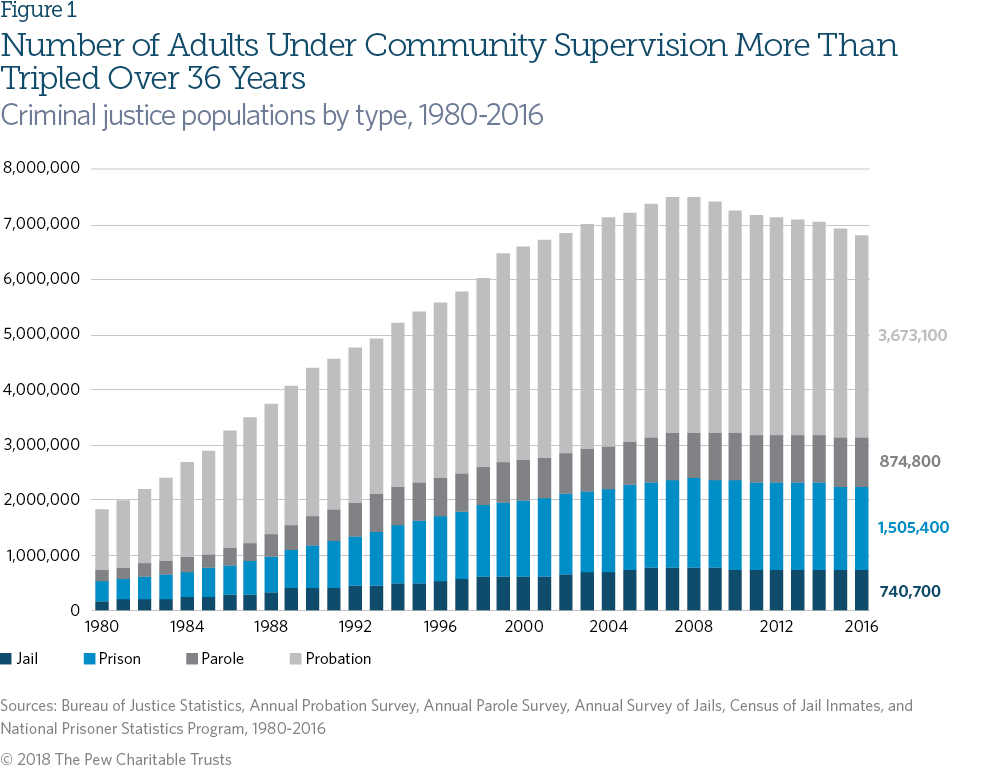
At the end of 2016, more than 4.5 million people were on probation or parole, accounting for two-thirds of the total correctional population. More than 3.6 million of those individuals were on probation, and the remaining 875,000 were on parole.1
The community corrections population peaked in 2007, and although it had declined 11 percent by 2016, it remained near its all-time high and was 239 percent larger than it was in 1980.2 Although the significant growth of the U.S. prison and jail populations over the past half-century has garnered substantial public and policymaker attention, this similar rise in the number of people on community supervision has been largely overlooked.
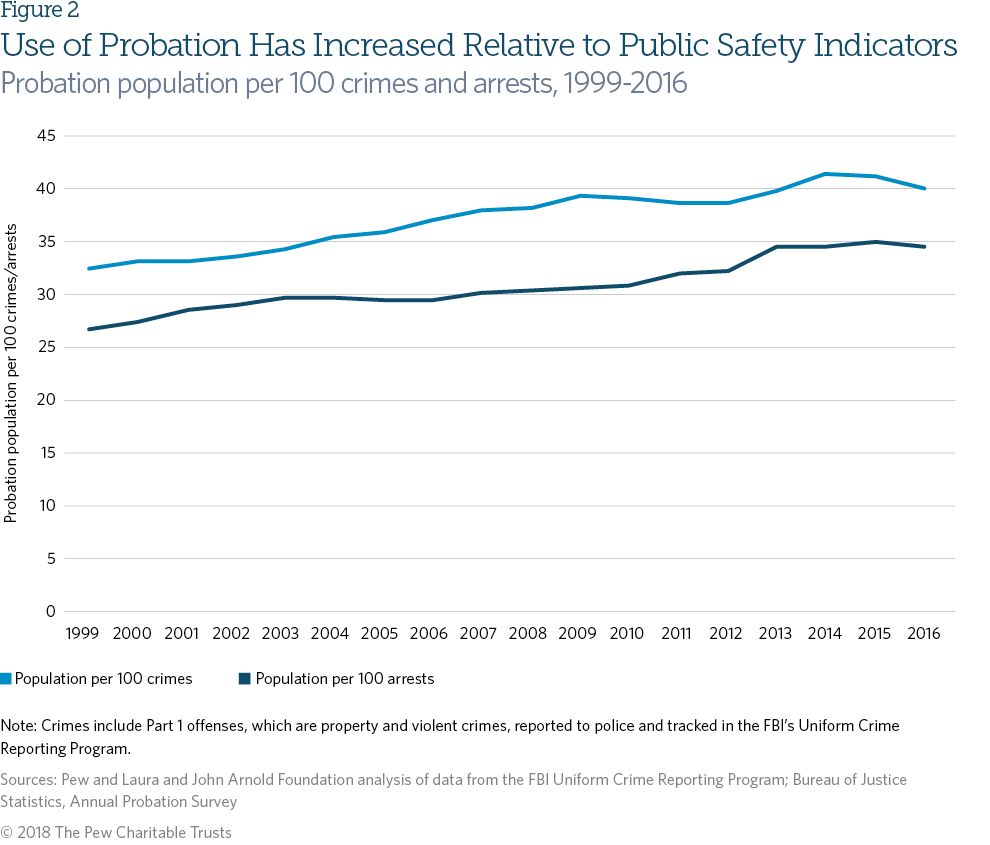
From 1999 to 2016, the probation population increased relative to the volume of crime and arrests. Specifically, the number of people on probation per crime rose 24 percent and per arrest rose by 28 percent. Although the reasons for the growth in supervision—or for the more recent decline—have not been well-studied these data indicate that crime is not the only factor influencing the size of probation populations; sentencing and corrections policies and practices also have an effect.3 This finding has a strong precedent—the lion's share of prison growth has been attributed to policy choices4—but more research is needed to understand these relationships and their implications for criminal justice policy.
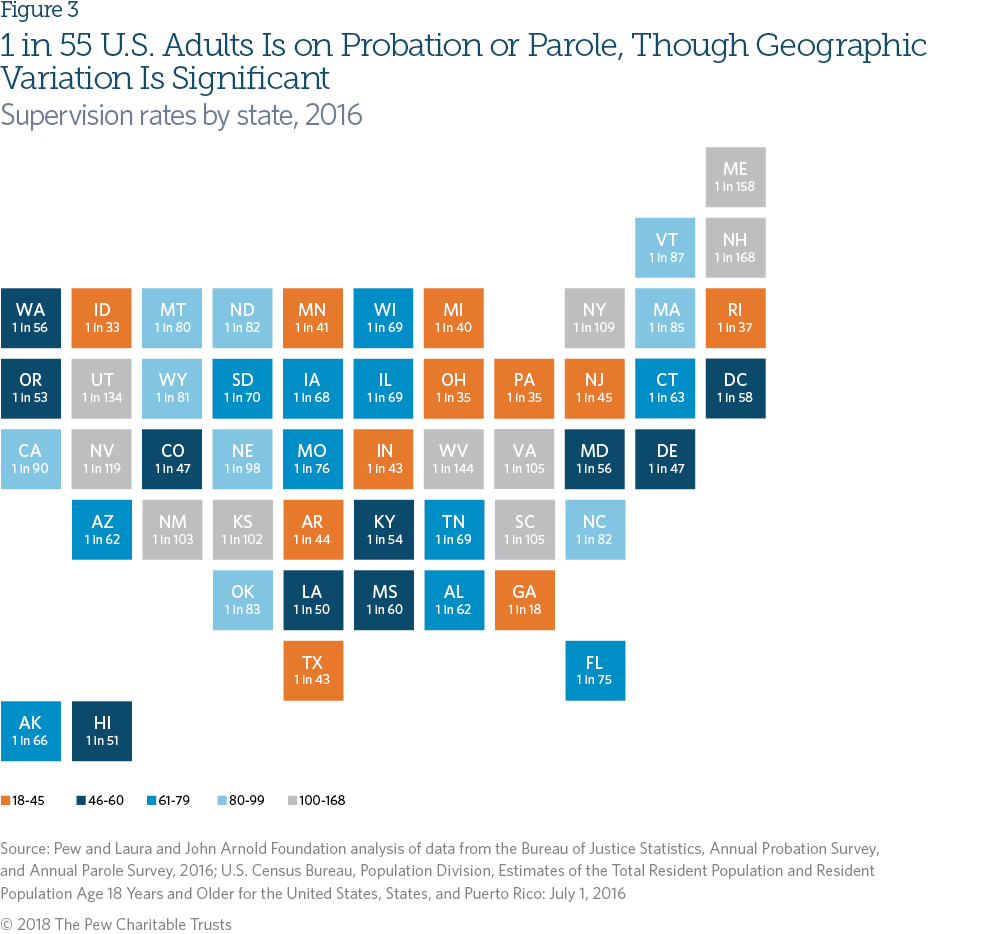
As probation and parole populations grew, so did the per capita rate of community supervision. Today, 1 in 55 adults in the U.S., or 4.5 million people, is subject to postconviction surveillance and court-ordered rules. That share is down 581,900 people from the 2007 peak of 1 in 45, but it still represents nearly 2 percent of American adults.
In addition, the national rate masks wide variation in how probation and parole are used across states. The share of people on community supervision ranges from 1 in 18 in Georgia to 1 in 168 in New Hampshire,5 and even among neighboring states with similar populations and political demographics, rates can differ significantly. For example, 1 in 33 adults in Idaho is on supervision compared with just 1 in 134 in Utah.
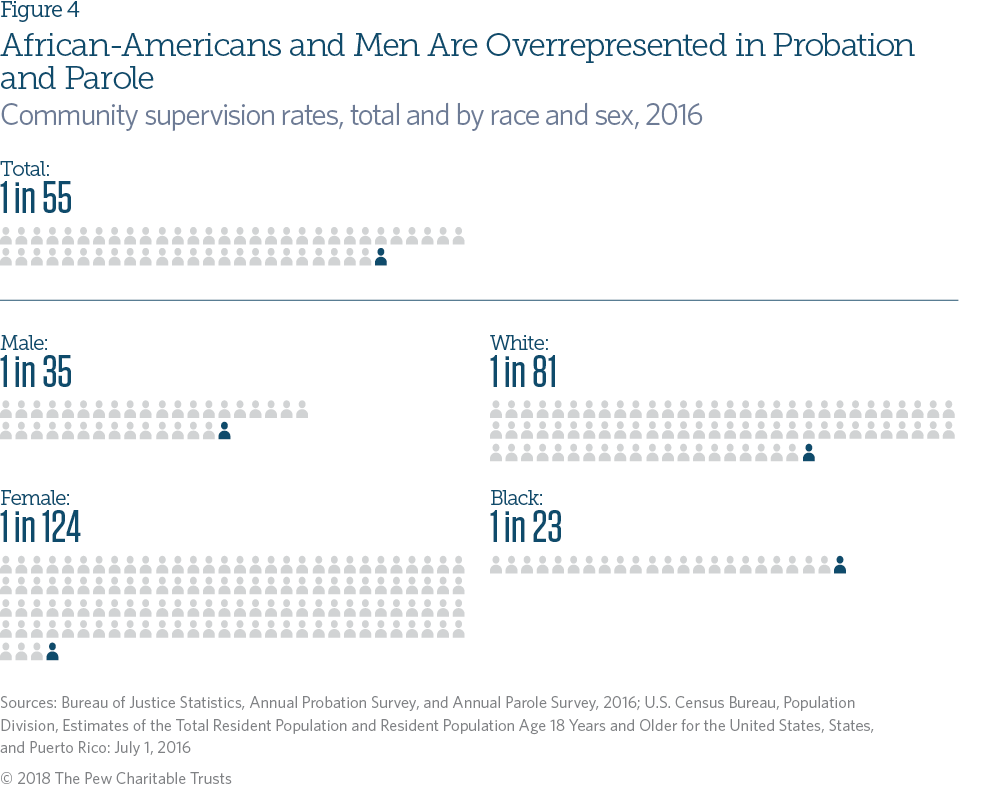
Virtually all demographic groups are represented in the community supervision population.6 However, people of color, particularly African-Americans, and men are disproportionately represented.
The racial gap resembles that in incarceration: Black adults are about 3.5 times as likely as whites to be supervised, and although African- Americans make up 13 percent of the U.S. adult population, they account for 30 percent of those on probation or parole. In addition, although federal data do not indicate disproportionate representation of Hispanics in community corrections, many states do not report ethnicity data, so Hispanics under supervision are undercounted.7
Imbalances also exist among females and males under supervision. Men are supervised at a rate about 3.5 times that of women. However, the share of women under supervision has nearly doubled from 520,000 in 1990 to more than 1 million at the end of 2016. As a result, women accounted for one-quarter of the probation population and 1 in 8 parolees by 2016.

At the end of 2016, 8 in 10 probationers and two-thirds of parolees had been sentenced for nonviolent crimes. Drug and property crimes each accounted for more than a million of the people on parole or probation that year.8 For a sense of scale, if individuals under supervision for drug crimes and those for property crimes each made up a city, they would rank among the 10 largest cities in the U.S.9
Unlike the prison population, which consists almost entirely of people convicted of felonies, the community supervision population includes people convicted of offenses ranging from the least serious misdemeanors to the most severe violent offenses. At least 4 in 10 probationers are being supervised for a misdemeanor offense; the ratio is probably higher, but the true figure is unknown because of a lack of data from some agencies that supervise only misdemeanants.10
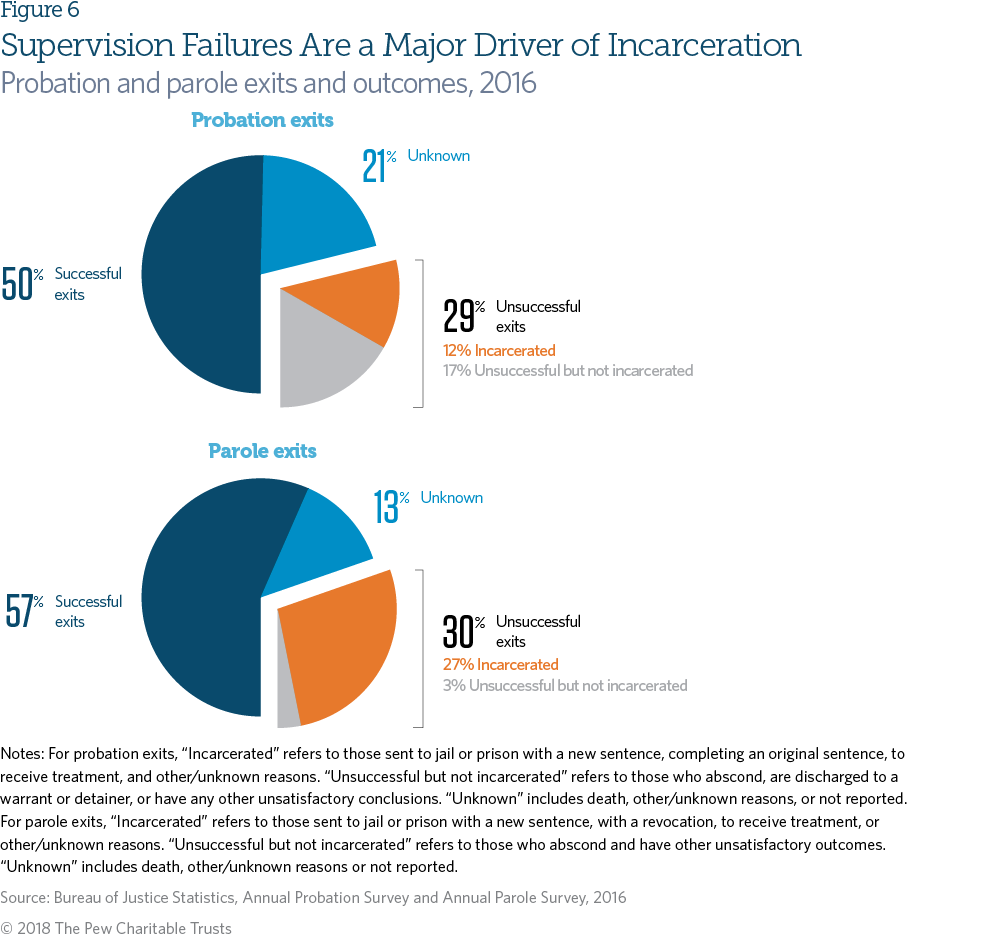
About half of people who exit parole or probation complete their supervision terms successfully. For the other half, failure is common and often leads to jail or prison. In 2016, 29 percent of the nearly 2 million probation exits were unsuccessful, and 12 percent (nearly a quarter of a million people) resulted in incarceration. Of approximately 425,000 parole exits, 30 percent were unsuccessful and 27 percent led to incarceration. All told, nearly 350,000 supervision failures result in prison or jail terms annually.
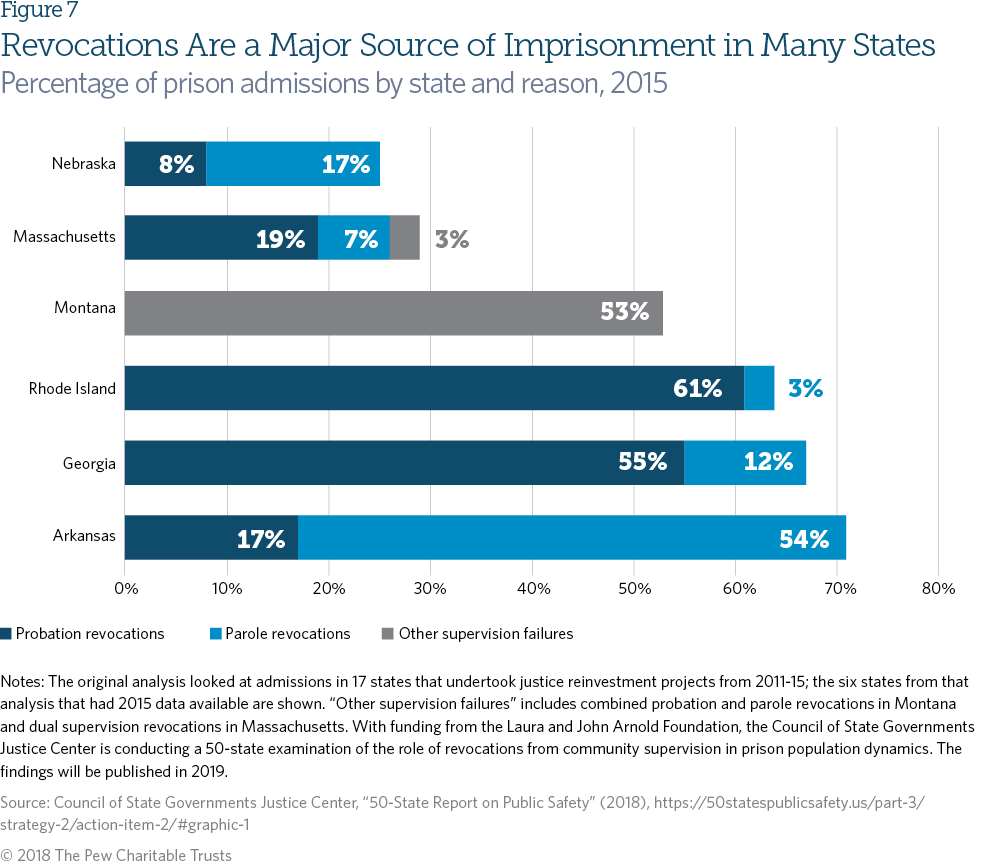
Although 50-state data are not available, research has found that probation and parole revocations contributed significantly to prison admissions in several states in 2015.11Probation revocations made up 55 percent of all prison admissions in Georgia and 61 percent in Rhode Island, while parole revocations accounted for 54 percent of all prison admissions in Arkansas. In some states, the proportions were significantly lower, such as Massachusetts, where probation and parole revocations accounted for just 19 and 7 percent of admissions, respectively, and Nebraska, where those figures were 8 and 17 percent.
One recent study concluded that "the largest alternative to incarceration in the United States is simultaneously one of the most significant drivers.
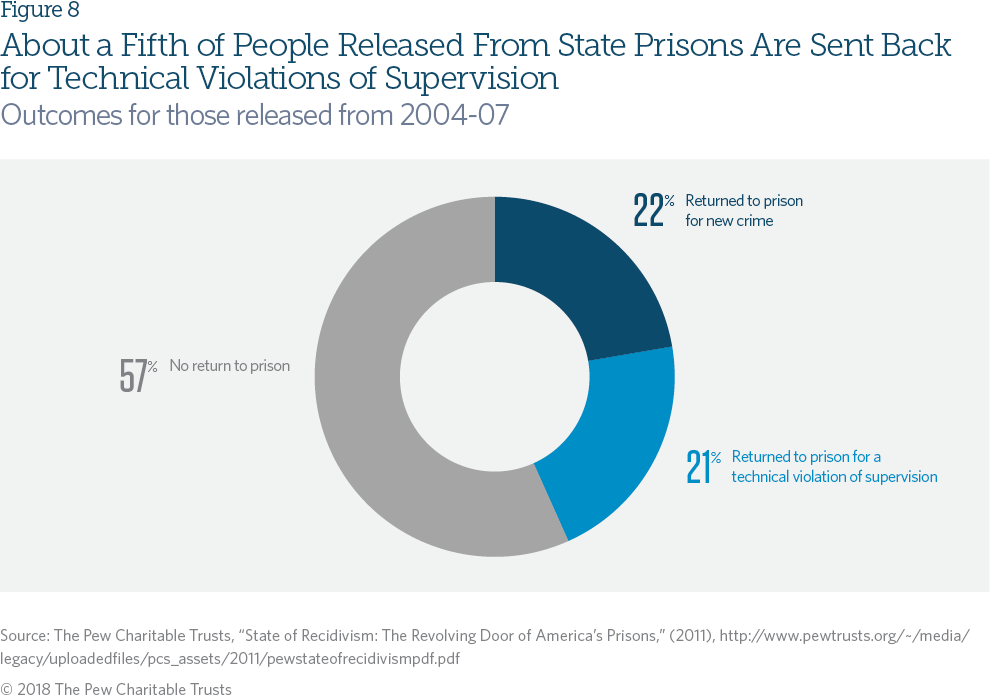
A study of individuals released from prison in 2004 in 41 states showed that the proportions sent back for a new crime and for a technical violation of supervision were nearly identical.13
Some data also suggest that people on probation and parole contribute disproportionately to arrests.14 In 2009, 18 percent of felony defendants in the 75 largest urban counties were on supervision at the time of their arrest. How many arrests are for new crimes versus rule violations is unknown, but research suggests that many may be the result of supervision practices that focus on catching mistakes through surveillance and monitoring, rather than on promoting success via rehabilitation and support.15More research is needed to understand these dynamics and develop policies to prevent new crimes and reduce revocations for technical violations.
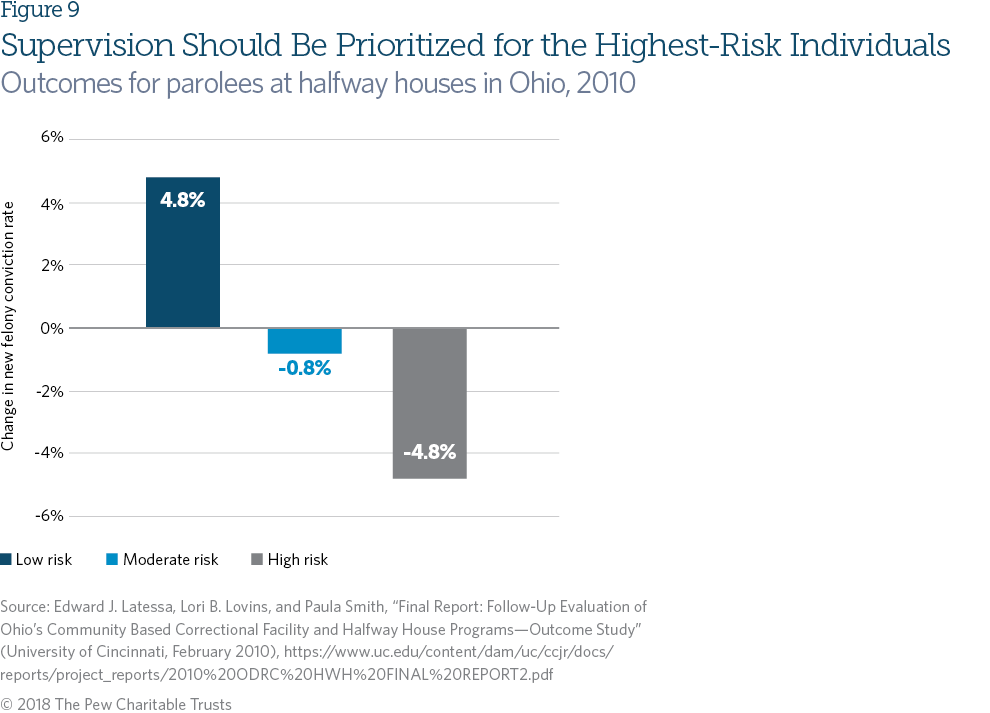
The large community corrections population and diverse risks and needs of people under supervision have made appropriately managing each person increasingly challenging. A large body of research has demonstrated the practicality and importance of classifying individuals based on their risk of recidivism and treatment needs and then prioritizing supervision and intervention resources on those most likely to benefit.16
For example, an evaluation of halfway house treatment programs in Ohio showed that, although the intervention effectively reduced recidivism for those considered highrisk, it increased reoffending among low-risk participants.17 Research has consistently shown that oversupervising low-risk individuals can do more harm than good by disrupting supportive elements of their lives, such as family, education, and employment, and mixing them in with people who are higher-risk.18 On the other hand, prioritizing resources and attention for high-risk individuals and those in need of treatment has been demonstrated to yield the greatest reductions in reoffending.19
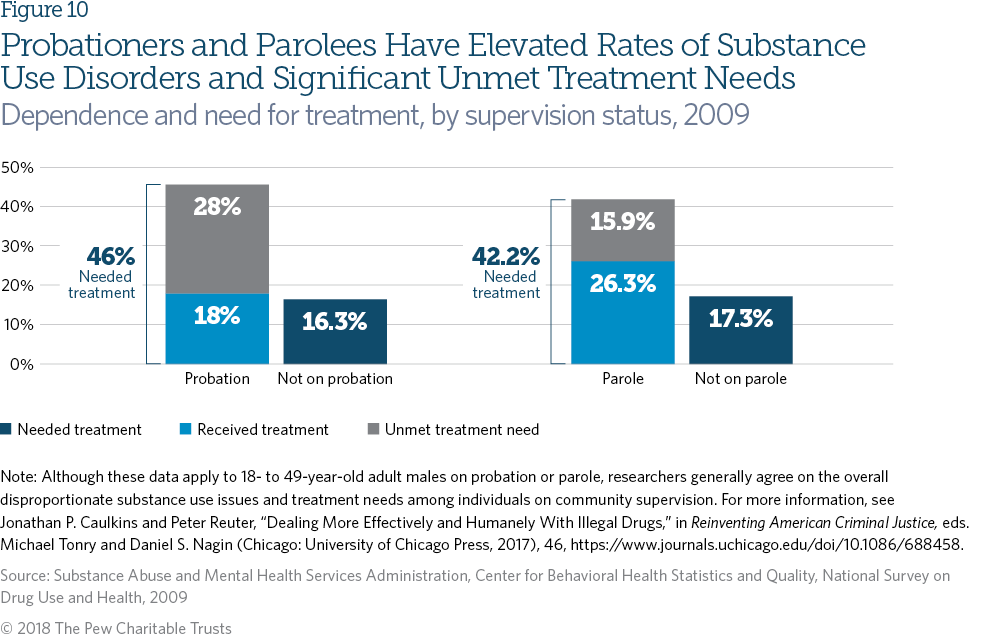
Nearly half of the community corrections population has a substance use disorder, and rates of substance use, misuse, and dependence are two to three times higher for people on probation and parole than for the general population.20
However, many people under supervision who could benefit from treatment do not receive it because of strained budgets, limited options in the community, or other factors.21 Research has found that a large share of the illicit drug problem is driven by a relatively small group of frequent users, many of whom are under correctional supervision.22 So the failure to provide substance use treatment represents a critical missed opportunity to reduce drug consumption and its costs to individuals, families, and communities.
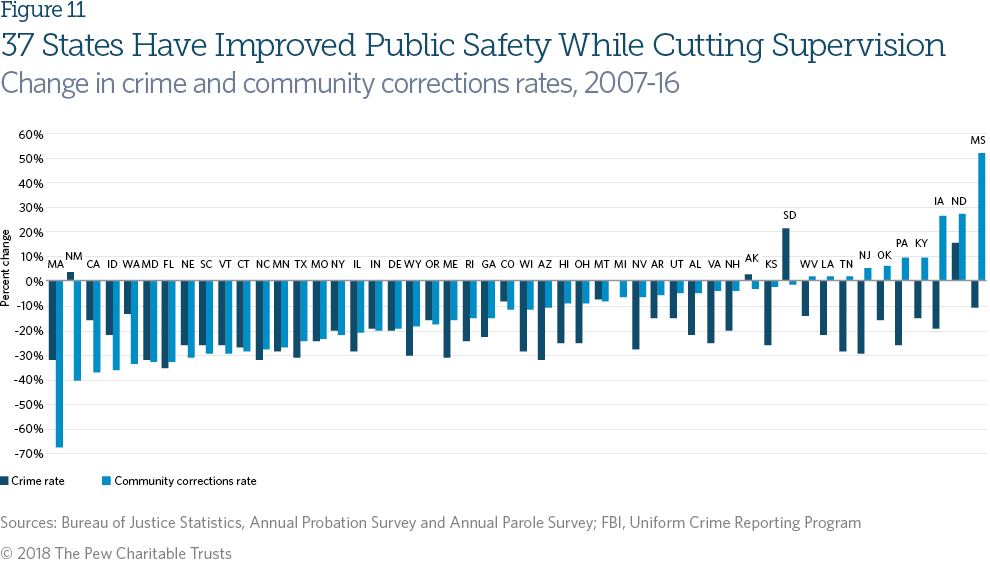
Research has shown that the growth in America's prison population had a real, if limited, effect on crime rates. However, public investments in increasing imprisonment passed the point of diminishing returns long ago, and 35 states have simultaneously reduced crime and imprisonment since 2008.23
Similarly, 37 states experienced drops in both community supervision and crime from 2007 to 2016.24 And some, such as Texas and South Carolina, cut their supervision and crime rates by 20 percent or more. As was the case with imprisonment, these declines often followed the adoption of evidence-based sentencing and corrections reforms that aim to improve public safety while ensuring accountability and controlling taxpayer costs. Policymakers have pursued these goals by prioritizing scarce community corrections resources for higher-risk individuals, investing in programs to reduce recidivism, and providing incentives for compliance with supervision rules.
Over the past quarter-century, researchers have identified a core set of strategies that can significantly reduce recidivism and thereby increase public safety and cut spending. These include scientifically validated tools to assess people's risk levels and treatment needs; individual case management plans that match people to appropriate supervision levels and treatment programs; cognitive behavioral and other evidence-based therapies to change behavior; and swift, certain, and proportionate sanctions and rewards for violations and compliance.
The community corrections field has increasingly embraced these essential building blocks of an evidence-based system, and many jurisdictions have seen encouraging results. But bigger gains are possible and urgently needed, given the stakes for those being supervised, for crime victims, and for families and communities.
This analysis suggests that the system is struggling to carry out its mandate. Progress will necessitate more than gradual adoption of specific practices and programs; it will require that the system shrink substantially and embrace major changes in policy and mission. An emerging consensus among criminal justice professionals supports a series of strategic shifts away from the current mass, time-based, isolated, and enforcement-minded model to one that is:25
- Focused. Direct supervision resources to those who pose a higher public safety risk instead of filling caseloads with low-risk people.
- Goal-based. Design supervision terms to end when people complete specific requirements or assigned programs, rather than when they have served a period of months or years.
- Integrated. Recognize how neighborhood and social factors affect behavior, and engage community members rather than relying heavily on pressure from the legal system.
- Constructive. Fundamentally change the purpose of supervision from punishing failure to promoting success. The goal should be to help people repair the harm they have caused and become self-sufficient, law-abiding citizens, rather than simply enforcing rules set by courts and parole boards, catching violations and imposing penalties, including incarceration.
Striking the right balance between accountability for violations and new crimes, and incentives for compliance and progress can improve outcomes. Ultimately, a more effective community corrections system will require a culture change: Policymakers and stakeholders must view people on supervision as capable of change and deserving of support.
Reforms Can Safely Reduce Supervision Caseloads, Revocations
After decades of growth, the community corrections population has dropped in several states that invested in research-based public safety strategies. Across the country, policymakers are adopting reforms that prioritize scarce resources for higher-risk individuals while removing lowerrisk people from supervision caseloads. Changes include shorter terms, earned compliance credits, and reduced or inactive supervision.
Some states also reduced revocations for technical violations and provided a range of options for addressing noncompliance. After South Carolina adopted graduated sanctions, compliance revocations decreased 46 percent, and people under supervision were 33 percent less likely to be incarcerated or reincarcerated than before the reforms. Similarly, after Louisiana implemented a 90-day cap on jail or prison terms for firsttime technical violations, length of incarceration declined by 281 days and new-crime revocations fell 22 percent. And after Missouri adopted earned discharge—in which probationers and parolees accrue time off their sentences for compliance— supervision terms dropped by 14 months, the supervised population fell 18 percent, average caseloads decreased 16 percent, and recidivism rates did not change.26
Conclusion
Community supervision is the largest component of the corrections system. The 4.5 million people on probation and parole are double the number in state, local, and federal prisons and jails combined. Although about half of these people successfully complete their terms, the sheer size of the population means that current failure rates contribute significantly to the nation's volume of arrests, drug misuse, and incarceration.
Over the past decade, a strong bipartisan consensus has fueled reforms in dozens of states aimed at safely reducing the nation's high rate of imprisonment while maintaining public safety. And that is exactly what's happening: Since its peak in 2008, the imprisonment rate has dropped 11 percent while the crime rate has fallen 23 percent.27 Crime reductions were, in fact, greater in states that had the biggest reductions in imprisonment.28 Thirty-seven states have also experienced simultaneous drops in community supervision and crime.
Yet compared with prison reform, which has been the focus of a broad national conversation, the issue of community corrections has received scant attention. It is time for that to change. By taking a similar data-driven approach to improving the community corrections system, leaders in all three branches of government can extend the gains already made to protect public safety, ensure accountability, and control taxpayer costs.
Appendix A: Methodology
Much of the data in this report come from the federal Bureau of Justice Statistics' Annual Probation and Annual Parole surveys, which are the only community corrections data collection that covers all 50 states, the District of Columbia, and the federal system. The 2016 survey was sent to 456 agencies in the states and the District, of which 414 were in the eight states without a centralized supervision system, and to the federal system. Some data issues do exist, including the following:
- Reporting methods have changed over time for some probation and parole agencies.
- An individual can enter or exit the system multiple times a year or be concurrently serving more than one sentence for separate crimes, but those duplications are not identified.
- Agencies vary in their ability to provide annual population counts that are consistent with Bureau of Justice Statistics definitions.
- Some agencies report the number of cases, while others report the number of individuals they supervise. Because an individual can have multiple probation sentences, counting cases can artificially inflate the totals. BJS requests that agencies report the number of individuals under supervision, and each year some agencies make the conversion, resulting in what appears to be a large decrease from previous years.
- Research suggests that probation totals are probably undercounted because some agencies report only felony sentences and some may include or exclude individuals on other forms of community control (e.g., diversion programs, private probation, and drug courts).
- The exit data had significant weaknesses, because many states either failed to collect the necessary information or provided estimates.
Georgia and Michigan did not provide year-end community corrections population figures; year-start figures (Jan. 1, 2016) were used as an estimate. Total community corrections rates and probation rates also were not provided but were calculated using year-start population figures and July 1, 2016, census figures.
Substance Abuse and Mental Health Services Administration treatment data are from the National Survey on Drug Use and Health, an annual survey of the general household population involving interviews with randomly selected individuals to examine trends in substance use disorders and receipt of treatment. The survey excludes people with no fixed address and residents of institutional group quarters, such as jails, and may not capture the entire population of arrestees. People on probation and parole are reported separately (i.e., counted twice). An individual was classified as needing treatment for a substance abuse problem if he or she met the criteria for dependence on or abuse of a substance or if he or she received treatment at a specialty facility, including a hospital (inpatient), rehabilitation facility (inpatient or outpatient), or mental health center in order to reduce or stop illicit drug or alcohol use, or for medical problems associated with illicit drug or alcohol use. Unmet treatment need refers to respondents classified as needing such treatment but not having received it.
Appendix B: State statistics

Endnotes
- The total community supervision population excludes parolees on probation to avoid double-counting and so will not equal the sum of probation and parole populations.
- The decline in the community corrections population is the result of the decrease in the probation population. The parole population has continued to grow slowly, increasing by 0.5 percent from 2015 to 2016.
- Michelle S. Phelps, "Mass Probation: Toward a More Robust Theory of State Variation in Punishment," Punishment & Society 19, no. 1 (2017): 53-73, https://pop.umn.edu/sites/pop.umn.edu/files/wp-2014-4.pdf.
- National Research Council, "The Growth of Incarceration in the United States: Exploring Causes and Consequences" (Washington, DC: The National Academies Press, 2014), https://www.nap.edu/catalog/18613/the-growth-of-incarceration-in-the-united-states-exploring-causes.
- Georgia and Michigan did not provide year-end community corrections population figures; year-start figures (Jan., 1, 2016) were used as an estimate. Those states also did not deliver total community corrections and probation rates, so they were calculated using year-start population figures and July 1, 2016, census figures.
- The Bureau of Justice Statistics provides only demographic data related to race/Hispanic origin and sex. The data do not allow for exploration of the relationship among those variables.
- Urban Institute, "The Alarming Lack of Data on Latinos in the Criminal Justice System" (2016), http://apps.urban.org/features/latino-criminal-justice-data/?language=english.
- Offense types may not add up because of rounding. Weapons offenses are broken out only for parole. If a probationer or parolee was convicted of more than one offense, he or she was categorized by the most serious one.
- U.S. Census Bureau, "Ten U.S. Cities Now Have 1 Million People or More; California and Texas Each Have Three of These Places," news release, May 21, 2015, https://www.census.gov/newsroom/press-releases/2015/cb15-89.html.
- Phelps, "Mass Probation."
- Council of State Governments Justice Center, "50-State Report on Public Safety" (2018), https://50statespublicsafety.us/workbooks. Research further indicates that revocation rates are higher for African-Americans and could exacerbate racial disparities in incarceration. See Michelle S. Phelps, "Mass Probation and Inequality: Race, Class, and Gender Disparities in Supervision and Revocation" in Handbook on Punishment Decisions: Locations of Disparity, eds. Jeffery T. Ulmer and Mindy S. Bradley (New York: Routledge, 2018), 1-426, https://books.google.com/books?hl=en&lr=&id=8yA6DwAAQBAJ&oi=fnd&pg=PT85&ots=ML0KaNr7Gd&sig=Ws8uaoA5bydYV4Jv7d7JfQkPhW0#v=onepage&q&f=false. Some scholars have referred to the phenomenon of probation and parole fueling prison admissions as a "back-end net-widening" effect. See Michelle S. Phelps, "The Paradox of Probation: Community Supervision in the Age of Mass Incarceration," Law Policy 35, no. 1-2 (2013): 51-80, https://www.ncbi.nlm.nih.gov/pmc/articles/PMC3780417; and Tony Fabelo et al., "A Ten-Step Guide to Transforming Probation Departments to Reduce Recidivism," Council of State Governments Justice Center (2011), https://www.bja.gov/Publications/CSG_10Step_Guide_Probation.pdf.
- Michael P. Jacobson et al., "Less Is More: How Reducing Probation Populations Can Improve Outcomes," Harvard Kennedy School Program in Criminal Justice Policy and Management (2017), https://www.hks.harvard.edu/sites/default/files/centers/wiener/programs/pcj/files/less_is_more_final.pdf.
- The Pew Charitable Trusts, "State of Recidivism: The Revolving Door of America's Prisons" (2011), http://www.pewtrusts.org/~/media/legacy/uploadedfiles/pcs_assets/2011/pewstateofrecidivismpdf.pdf.
- Brian A. Reaves, "Felony Defendants in Large Urban Counties, 2009—Statistical Tables," U.S. Department of Justice, Bureau of Justice Statistics (2013), https://www.bjs.gov/content/pub/pdf/fdluc09.pdf.
- Michelle S. Phelps, "The Paradox of Probation"; Fabelo, "A Ten-Step Guide to Transforming Probation Departments."
- D.A. Andrews, James Bonta, and R.D. Hoge, "Classification for Effective Rehabilitation: Rediscovering Psychology," Criminal Justice and Behavior 17, no. 1 (1990): 19-52, https://doi.org/10.1177/0093854890017001004; Dena Hanley, "Appropriate Services: Examining the Case Classification Principle," Journal of Offender Rehabilitation 42, no. 4 (2006): 1-22, https://doi.org/10.1300/J076v42n04_01; Christopher T. Lowenkamp, Edward J. Latessa, and Alexander M. Holsinger, "The Risk Principle in Action: What Have We Learned From 13,676 Offenders and 97 Correctional Programs?" Crime & Delinquency 52, no. 1 (2006): 77-93, https://doi.org/10.1177/0011128705281747; Jesse Jannetta and William Burrell, "Effective Supervision Principles for Probation and Parole," in Encyclopedia of Criminology and Criminal Justice, eds. Gerben Bruinsma and David Weisburd (New York: Springer, 2014), https://doi.org/10.1007/978-1-4614-5690-2_24.
- Edward J. Latessa, Lori B. Lovins, and Paula Smith, "Final Report: Follow-Up Evaluation of Ohio's Community Based Correctional Facility and Halfway House Programs—Outcome Study" (2010), https://www.uc.edu/content/dam/uc/ccjr/docs/reports/project_reports/2010%20ODRC%20HWH%20FINAL%20REPORT2.pdf.
- The Pew Charitable Trusts, "Risk/Needs Assessment 101: Science Reveals New Tools to Manage Offenders" (2011), http://www.pewtrusts.org/~/media/legacy/uploadedfiles/pcs_assets/2011/pewriskassessmentbriefpdf.pdf; D.A. Andrews and James Bonta, The Psychology of Criminal Conduct (New York: Routledge, 2010), https://www.taylorfrancis.com/books/9781317521501.
- Christopher T. Lowenkamp and Edward J. Latessa, "Understanding the Risk Principle: How and Why Correctional Interventions Can Harm Low-Risk Offenders," Topics In Community Corrections (2004), http://caparc.org/uploads/3/5/2/7/35276822/high_low_risk_article.pdf; Lowenkamp, Latessa, and Holsinger, "The Risk Principle in Action."
- Thomas E. Feucht and Joseph Gfroerer, "Mental and Substance Use Disorders Among Adult Men on Probation or Parole: Some Success Against a Persistent Challenge," Substance Abuse and Mental Health Services Administration (2011), https://www.ncjrs.gov/pdffiles1/nij/235637.pdf.
- Substance Abuse and Mental Health Services Administration, "The NSDUH Report: Trends in Substance Use Disorders Among Males Aged 18 to 49 on Probation or Parole" (2014), https://www.samhsa.gov/data/sites/default/files/sr084-males-probation-parole/sr084-males-probation-parole/sr084-males-probation-parole.htm.
- Jonathan P. Caulkins and Peter Reuter, "Dealing More Effectively and Humanely With Illegal Drugs," Crime and Justice 46 (2017): 95-158, https://www.journals.uchicago.edu/doi/10.1086/688458.
- The Pew Charitable Trusts, "National Prison Rate Continues to Decline Amid Sentencing, Re-Entry Reforms" (2018), http://www.pewtrusts.org/en/research-and-analysis/articles/2018/01/16/national-prison-rate-continues-to-decline-amid-sentencing-re-entry-reforms.
- Twenty-seven of these states also saw a decline in their imprisonment rates during the same period.
- Harvard Kennedy School, "Toward an Approach to Community Corrections for the 21st Century: Consensus Document of the Executive Session on Community Corrections" (2017), https://www.hks.harvard.edu/sites/default/files/centers/wiener/programs/pcj/files/Consensus_Final2.pdf; Columbia Justice Lab, "Statement on the Future of Community Corrections" (2018), http://justicelab.iserp.columbia.edu/statement.html.
- Elizabeth Pelletier et al., "Assessing the Impact of South Carolina's Parole and Probation Reforms," Urban Institute (2017), https://www.urban.org/sites/default/files/publication/89871/south_carolina_jri_policy_assessment_final_1.pdf; The Pew Charitable Trusts, "Missouri Policy Shortens Probation and Parole Terms, Protects Public Safety: Individuals on Community Supervision Can Earn Credits to Reduce Their Sentences" (2016), http://www.pewtrusts.org/~/media/assets/2016/08/missouri_policy_shortens_probation_and_parole_terms_protects_public_safety.pdf; The Pew Charitable Trusts, "Reducing Incarceration for Technical Violations in Louisiana: Evaluation of Revocation Cap Shows Cost Savings, Less Crime" (2014), http://www.pewtrusts.org/~/media/assets/2014/11/psppreducingincarcerationfortechnicalviolationsinlouisiana.pdf.
- The Pew Charitable Trusts, "National Prison Rate Continues to Decline Amid Sentencing, Re-Entry Reforms."
- Ibid.
ADDITIONAL RESOURCES
MORE FROM PEW
petherickacketwound.blogspot.com
Source: https://www.pewtrusts.org/en/research-and-analysis/issue-briefs/2018/09/probation-and-parole-systems-marked-by-high-stakes-missed-opportunities
0 Response to "Continued Drug Use on Probation parole is a Common Reason for"
Post a Comment